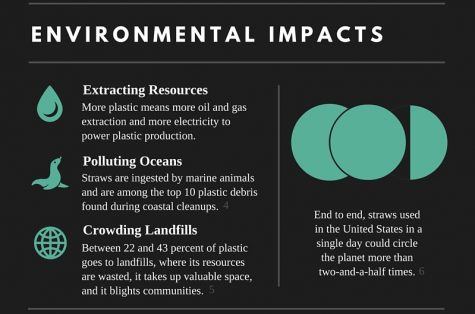Last straw on the overflow of waste
A toxic truth on the abundance of trash

September 21, 2018
Non-biodegradable products, items that cannot be broken down by bacteria, are leading to the world drowning in its own waste.
Annually, more than 14 billion pounds of garbage is dumped into the world’s ocean and 230 million pounds end up in the United State’s landfills according to the Environmental Protection Agency.
Air pollution, caused by the burning of waste, was linked to 6.5 million deaths caused by cancers, chemical poisoning, respiratory diseases and birth defects. With the constant flow of trash is the constant flow of toxins. This must be avoided to increase the health of civilians.

Trash is an inevitable part of life, we can’t deny it at this point. The only possible solution is to start a change by dialing down the abundance of trash being produced by each person.
According to the EPA, the average person generates 4.4 pounds of trash every day, however 75% that could be recycled yet is thrown into landfills.
There are several different types of products that can be cut down on to help with this dilemma that every person should incorporate into their daily routine to obtain a zero waste life- a style of life which revolves around creating the least amount of trash as possible. Products such as plastic bags, water bottles, toothbrushes and plenty other unnecessary package goods can all be replaced with better alternatives to help eliminate some of the pollution in our world. Most importantly, at the moment, straws are the main concern as they are most used, non-biodegradable products used in the United States, according to the EPA.

A plastic straw- It’s a thin tube made available in most restaurants, houses, schools and basically any place that supplies beverages. A straw seems minuscule in the amount of trash a person produces daily, so what’s with all the commotion?
According to the National Parks Service, Americans alone use 500 million straws a day, enough to fill up 125 buses. That’s 125 buses full of non-recyclable material, due to the fact that straws are made out of polypropylene, which is a byproduct of petroleum, a fossil fuel that requires an incredible amount of energy and natural resources to extract and refine.
Around a million seabirds and thousands of marine life die each year by ingesting these straws thrown away into their habitats. In August of 2015, a video of a sea turtle struggling to breathe blew up and created mass controversy over the use of straws.
In the video Christine Figgener, a marine biologist, spent eight minutes removing a straw lodged within a sea turtle’s nose. The horrendous image of blood dripping out of the turtle as it sneezes and squeals hurts the hearts of the viewers, triggering the now current movement that is affecting global businesses.

The idea that the carelessness of society is leading to the deaths of innocent animals is overall depressing and shameful. People should become responsible for their actions, yet the whole world turns its back on the fact that this is a major problem. The ignorance of humans is what is leading to trash covering not just the ecosystems of animals, but it will eventually lead to the deaths of humans as waste takes over more cities in need of landfills. Thankfully, more companies are realizing this.
With the new trend of being eco-friendly swamping different media sources, business have started to catch on and are trying to draw attention towards their company by attracting new types of customers with new eco-friendly products. Straws are now being eliminated to support the health of animals and humans.

Biodegradable drinking lids, paper straws, and metal straws are a few alternative, along with having to pay to use a plastic straw. While each material comes with its own expense, efficiency and hassle, companies are hoping that its followers will transform with them in eliminating plastic straws.
Other plastic materials, such as plastic bags, are also causing new movements. Every year 1 trillion plastic bags are used world wide. According to EPA, these bags get into soil and slowly release toxic chemicals. They eventually break down into the soil, with the unfortunate result being that animals eat them and often choke and die.
After complaints and concerns, some stores are changing around five cents per plastic bag used. California itself has banned the use of single-use plastic bag. Overall one of the most efficient dupes for plastic bags would be using reusable bags. Paper bags are also an option but scientifically, according to Reuse This Bag, paper bags take almost as long as plastic bags to make and waste more energy to be produced.
Plastic bottles are also a common plastic that pollutes our Earth. Around 60 million bottles end up in landfills each year. Differentiating from straws and bags, bottles can be recycled, yet most of them end up in landfills or the ocean which disturbs different animal’s ecosystems and similarly as stated before, leads to the release of toxins that are breathed in every day.
Making a change isn’t that hard. With alternatives such as reusable bags, water bottles and metal straws, the question of eliminating these plastic cancer causing materials is a given.
If people tried hard enough and were alerted of the dangers at hand, the amount of trash could be cut in half, the amount of deaths would decrease and less toxic materials would be floating around.
Eventually we as a race might not have a chance to take back all the pollution we have done, this is the last straw on our waste production. Hopefully in the future will have learned from our mistakes.






